
The double feature is a motion picture industry phenomenon in which theatres would exhibit two films for the price of one, supplanting an earlier format in which the presentation of one feature film would be followed by various short subject reels.

The double feature is a motion picture industry phenomenon in which theatres would exhibit two films for the price of one, supplanting an earlier format in which the presentation of one feature film would be followed by various short subject reels.
Opera houses staged two operas together for the sake of providing long performance for the audience. This was related to one-act or two-act short operas that were otherwise commercially hard to stage alone. A prominent example is the double-bill of Pagliacci with Cavalleria rusticana first staged on 22 December 1893 by the Met. The two operas have since been frequently performed as a double-bill, a pairing referred to in the operatic world colloquially as "Cav and Pag". [1]
The double feature originated in the later 1930s.[ citation needed ] Though the dominant presentation model, consisting of all or some of the following, continued well into the 1940s:
With the widespread arrival of sound film in American theaters in 1929, many independent exhibitors began dropping the then-dominant presentation model. Movie theaters suffered a downturn in business in the early years of the Great Depression.
Theater owners decided they could both attract more customers and save on costs if they offered two movies for the price of one. The tactic worked; audiences considered the cost of a theater ticket good value for several hours of escapist and varied entertainment and the practice became a standard pattern of programming.
In the typical 1930s double bill, the screening began with a variety program consisting of trailers, a newsreel, a cartoon and/or a short film preceding a low-budget second feature (the B movie), followed by a short interlude. Lastly, the high-budget main feature (the A movie) ran.
A neighborhood theatre running a double feature won out over a higher-priced first-run theatre with only one feature film. The major studios took note of this, and began making their own B features using the technicians and sets of the studio and featuring stars on their way up or on their way down. The major studios also made film series featuring recurring characters.[ citation needed ]
Although the double feature put many short comedy producers out of business, it was the primary source of revenue for smaller Hollywood studios, such as Republic and Monogram, that specialized in B movie production.[ citation needed ]
In 1910, double features were banned in France. The ban was lifted in 1953 but with one of the features having to be more than 10 years old. [2]

The double feature arose partly because of a studio practice known as "block booking," a form of tying, in which major Hollywood studios required theaters to buy B-movies along with the more desirable A-movies. In 1948, the U.S. Supreme Court decided that the practice was illegal in United States v. Paramount Pictures, Inc. , contributing to the end of the studio system.
Without block booking, the studios no longer had an incentive to make their own B-features. But audiences at first-run movie palaces, neighborhood theatres, and drive-in theatres, still expected a program of two features. In 1948, nearly two-thirds of the movie houses in the United States were advertising double features. [3]
Following the Supreme Court ruling of 1948, known as the Paramount Consent Decree, the source for the second feature changed. [4] The second feature could be:
James H. Nicholson and Samuel Z. Arkoff formed American International Pictures in the mid-1950s to produce and distribute low-budget features. They discovered exhibitors were only interested in buying their pictures as supporting features (a B-movie) at a flat rate. Once Nicholson and Arkoff combined two features into a program, sold as a double bill, with each picture given equal billing in the advertising and backed up with an explosive advertising campaign, theaters were willing to exhibit them on a percentage basis. [5] The exhibitors may have kept a larger share of the box office than the major distributors demanded, [6] but AIP's share of the box office was enough to keep it from going out of business.
The double bill was sold on a percentage basis and each feature was given equal billing in newspaper advertisements and promotional materials. Since the trailers and advertising promoted the two titles, exhibitors were discouraged from separating the features in the package. To distributors and exhibitors, it was a substantially different policy than the standard double feature in that it was not a top-billed A feature combined with a minor-billed support feature sold at a flat rate (a B movie).
By the mid-1960s, double features had been mostly abandoned in non–drive-ins in favor of the modern single-feature screening, in which only one feature film is exhibited. However, double bills of popular series that had previously been run as a single feature, such as the James Bond and Matt Helm series in the superspy genre, and the Man with No Name and The Stranger spaghetti Westerns were re-released together by the main studios.
The end of the first-run double feature also saw the end of continuous screenings, an exhibition policy where a theater opened at 10:30 or 11:00 AM and ran the program without breaks until 12:00 midnight. Customers bought tickets and entered the theater at any time during the program.
The Rocky Horror Picture Show, and its 1973 stage predecessor The Rocky Horror Show, reference the practice in their opening song "Science Fiction/Double Feature" and are largely inspired by B movies presented in these showings. The movie itself was and still is often shown as a double feature with Shock Treatment, a loose follow-up by the same directors.
While most cinemas have long discontinued the practice of showing the double feature, it has nostalgic appeal. The Astor Theatre in St. Kilda, Melbourne, Australia, established in 1936, continues the tradition of the double feature to this day. Many repertory houses continue to show two films, usually related in some way, back to back.
Short films still occasionally precede the feature presentation (Pixar films generally feature a short, for example), but the double feature is now effectively extinct in first-run movie theaters in the U.S.
Following the success of Who Framed Roger Rabbit , three Roger Rabbit cartoon shorts were created to be shown as preludes to other Disney films, in an effort to revive the viewing of cartoon shorts before major films. Only three were made and the scheme failed. [7]
During the 1990s, many VHS cassettes that contained two films on the same tape (with the second often a sequel to the first) were described as "double features," a practice that was later extended to DVDs.

In 2007, filmmakers Quentin Tarantino and Robert Rodriguez released their individual films Planet Terror and Death Proof as a double feature under the title Grindhouse , edited together with fake exploitation film trailers and 1970s-era snipes in order to replicate the experience of viewing a double feature in a grindhouse theater. Although Grindhouse received critical acclaim, it was a complete financial flop in the United States. The films were screened individually in international markets and on DVD.
Another recent double feature was the Duel Project, when Japanese directors Ryuhei Kitamura and Yukihiko Tsutsumi created competing films to be shown and voted on by the premier audience.
One of the Marvel Animated Features, a direct-to-video series features Hulk vs. which is a double feature, has Hulk vs. Wolverine and Hulk vs. Thor.
More recently, double features of re-released popular films hit the big screen. The first was of the re-release of Toy Story and Toy Story 2 that started on October 2, 2009, before the release of Toy Story 3 the following year. Both films were distributed in Disney Digital 3D in select theaters. [8] The next double feature was a re-release of Twilight and The Twilight Saga: New Moon on June 29, 2010, shortly before the midnight screening of The Twilight Saga: Eclipse in select theaters. [9] In February 2011, it was announced that the 14th Pokémon movie Victini and the Black Hero: Zekrom and Victini and the White Hero: Reshiram , due in July, would be released as a double feature, though both films are actually "versions" of each other, with differences related to plot points and character designs varying between the version being watched.
In 2022, Russian cinema launched double features with American and Russian movies. The first film is a Hollywood blockbuster, it designated as "free pre-feature service". The second film, designated as main feature, is Russian patriotic propaganda movie or short film (tickets are sold for it). [10] [11]
In 2023, many theaters began offering double features for Barbie and Oppenheimer as part of the "Barbenheimer" phenomenon. The two films –which were noted for their tonal and genre contrast –were released on July 21 in the United States and several other countries. [12]

A movie theater, cinema, or cinema hall, also known as a movie house, picture house, picture theater or simply theater, is a business that contains auditoria for viewing films for public entertainment. Most are commercial operations catering to the general public, who attend by purchasing tickets.
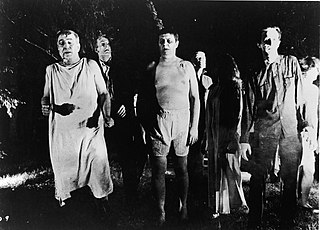
A B movie, or B film, is a type of low-budget commercial motion picture. Originally, during the Golden Age of Hollywood, this term specifically referred to films meant to be shown as the lesser-known second half of a double feature, somewhat similar to B-sides in the world of recorded music. However, the production of such films as "second features" in the United States largely declined by the end of the 1950s. This shift was due to the rise of commercial television, which prompted film studio B movie production departments to transition into television film production divisions. These divisions continued to create content similar to B movies, albeit in the form of low-budget films and series.
American International Pictures LLC is an American film production company owned by Amazon MGM Studios. In its original operating period, AIP was an independent film production and distribution company known for producing and releasing films from 1955 until 1980, a year after its acquisition by Filmways in 1979.
3D films are motion pictures made to give an illusion of three-dimensional solidity, usually with the help of special glasses worn by viewers. They have existed in some form since 1915, but had been largely relegated to a niche in the motion picture industry because of the costly hardware and processes required to produce and display a 3D film, and the lack of a standardized format for all segments of the entertainment business. Nonetheless, 3D films were prominently featured in the 1950s in American cinema, and later experienced a worldwide resurgence in the 1980s and 1990s driven by IMAX high-end theaters and Disney-themed venues. 3D films became increasingly successful throughout the 2000s, peaking with the success of 3D presentations of Avatar in December 2009, after which 3D films again decreased in popularity. Certain directors have also taken more experimental approaches to 3D filmmaking, most notably celebrated auteur Jean-Luc Godard in his film Goodbye to Language.
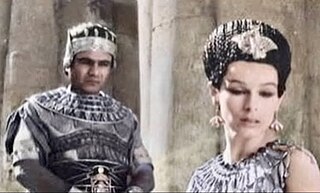
A short film is a film with a low running time. The Academy of Motion Picture Arts and Sciences defines a short film as "an original motion picture that has a running time of not more than 40 minutes including all credits". In the United States, short films were generally termed short subjects from the 1920s into the 1970s when confined to two 35 mm reels or less, and featurettes for a film of three or four reels. "Short" was an abbreviation for either term.

The Kentucky Fried Movie is a 1977 American independent anthology sketch black comedy film, produced by Kim Jorgensen, Larry Kostroff, and Robert K. Weiss, and directed by John Landis. Among the numerous star cameos are George Lazenby, Bill Bixby, Henry Gibson, Barry Dennen, Donald Sutherland, Tony Dow, Stephen Bishop, and the voice of Shadoe Stevens. According to writer David Zucker on the DVD commentary track, David Letterman auditioned for the role of the newscaster, but was not selected. The film also features many former members of The Groundlings and The Second City. The "feature presentation" portion of the film stars Evan C. Kim and hapkido grand master Bong Soo Han. The Kentucky Fried Movie marked the first film appearances of a number of actors who later became famous, and launched the careers of the Zucker brothers, Abrahams and Landis.

A grindhouse or action house is an American term for a theatre that mainly shows low-budget horror, splatter, and exploitation films for adults. According to historian David Church, this theater type was named after the "grind policy", a film-programming strategy dating back to the early 1920s which continuously showed films at cut-rate ticket prices that typically rose over the course of each day. This exhibition practice was markedly different from the era's more common practice of fewer shows per day and graduated pricing for different seating sections in large urban theatres, which were typically studio-owned.
A film distributor is responsible for the marketing of a film. The distribution company may be the same with, or different from, the production company. Distribution deals are an important part of financing a film.
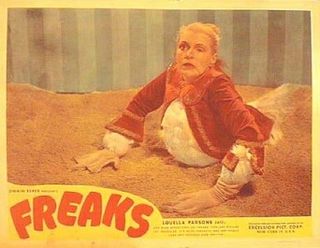
The term midnight movie is rooted in the practice that emerged in the 1950s of local television stations around the United States airing low-budget genre films as late-night programming, often with a host delivering ironic asides. As a cinematic phenomenon, the midnight screening of offbeat movies began in the early 1970s in a few urban centers, particularly in New York City with screenings of El Topo at the Elgin Theater, eventually spreading across the country. The screening of non-mainstream pictures at midnight was aimed at building a cult film audience, encouraging repeat viewing and social interaction in what was originally a countercultural setting.

Grindhouse is a 2007 American film written and directed by Robert Rodriguez and Quentin Tarantino. Presented as a double feature, it combines Rodriguez's Planet Terror, a horror comedy about a group of survivors who battle zombie-like creatures, and Tarantino's Death Proof, an action thriller about a murderous stuntman who kills young women with modified vehicles. The former stars Rose McGowan, Freddy Rodriguez, Michael Biehn, Jeff Fahey, Josh Brolin, and Marley Shelton; the latter stars Kurt Russell, Rosario Dawson, Vanessa Ferlito, Jordan Ladd, Sydney Tamiia Poitier, Tracie Thoms, Mary Elizabeth Winstead, and Zoë Bell. Grindhouse pays homage to exploitation films of the 1970s, with its title deriving from the now-defunct theaters that would show such films. As part of its theatrical presentation, Grindhouse also features fictitious exploitation trailers directed by Rodriguez, Rob Zombie, Edgar Wright, Eli Roth, and Jason Eisener.

A multiplex is a movie theater complex with multiple screens or auditoriums within a single complex. They are usually housed in a specially designed building. Sometimes, an existing venue undergoes a renovation where the existing auditoriums are split into smaller ones, or more auditoriums are added in an extension or expansion of the building. The largest of these complexes can sit thousands of people and are sometimes referred to as a megaplex.
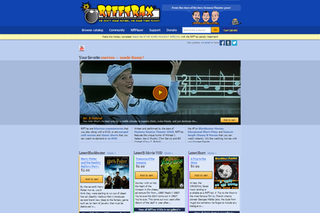
RiffTrax is an American company that produces scripted humorous commentary tracks which are synced to feature films, education shorts, and television episodes. With the talents of former Mystery Science Theater 3000 (MST3K) cast members and writers, RiffTrax also produces several live shows each year which are broadcast to movie theaters. The style of commentating originated from MST3K, their earlier television series, in which they would similarly mock films aloud while watching them. As of September 2023, RiffTrax has riffed 522 feature films, 462 short films, and 16 TV episodes.
James Harvey Nicholson was an American film producer. He is best known as the co-founder, with Samuel Z. Arkoff, of American International Pictures.

The B movie, whose roots trace to the silent film era, was a significant contributor to Hollywood's Golden Age of the 1930s and 1940s. As the Hollywood studios made the transition to sound film in the late 1920s, many independent exhibitors began adopting a new programming format: the double feature. The popularity of the twin bill required the production of relatively short, inexpensive movies to occupy the bottom half of the program. The double feature was the predominant presentation model at American theaters throughout the Golden Age, and B movies constituted the majority of Hollywood production during the period.

The 1950s mark a significant change in the definition of the B movie. The transformation of the film industry due to court rulings that brought an end to many long-standing distribution practices as well as the challenge of television led to major changes in U.S. cinema at the exhibition level. These shifts signaled the eventual demise of the double feature that had defined much of the American moviegoing experience during Hollywood's Golden Age of the 1930s and 1940s. Even as the traditional bottom-of-the-bill second feature slowly disappeared, the term B movie was applied more broadly to the sort of inexpensive genre films that came out during the era, such as those produced to meet the demands of the burgeoning drive-in theater market.
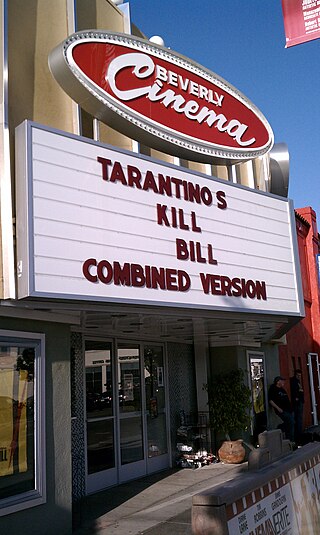
The New Beverly Cinema is a historic movie theater located in Los Angeles, California. Housed in a building that dates back to the 1920s, it is one of the oldest revival houses in the region. Since 2007, it has been owned by the filmmaker Quentin Tarantino.

Block booking is a system of selling multiple films to a theater as a unit. Block booking was the prevailing practice in the Hollywood studio system from the turn of the 1930s until it was outlawed by the U.S. Supreme Court's decision in United States v. Paramount Pictures, Inc. (1948). Under block booking, "independent ('unaffiliated') theater owners were forced to take large numbers of a studio's pictures without knowing much about them. Those studios could then parcel out B movies along with A-class features and star vehicles, which made both production and distribution operations more economical." The element of the system involving the purchase of unseen pictures is known as blind bidding.

The musical short can be traced back to the earliest days of sound films.

Nitehawk Cinema is a dine-in independent movie theater in Brooklyn, New York City. It operates two locations, in the neighborhoods of Williamsburg and Park Slope. The theater, which offers a menu of food and drinks that can be ordered and consumed while patrons view films, was the first liquor licensed movie theater in the state of New York, and the first movie theater in New York City to offer table service.